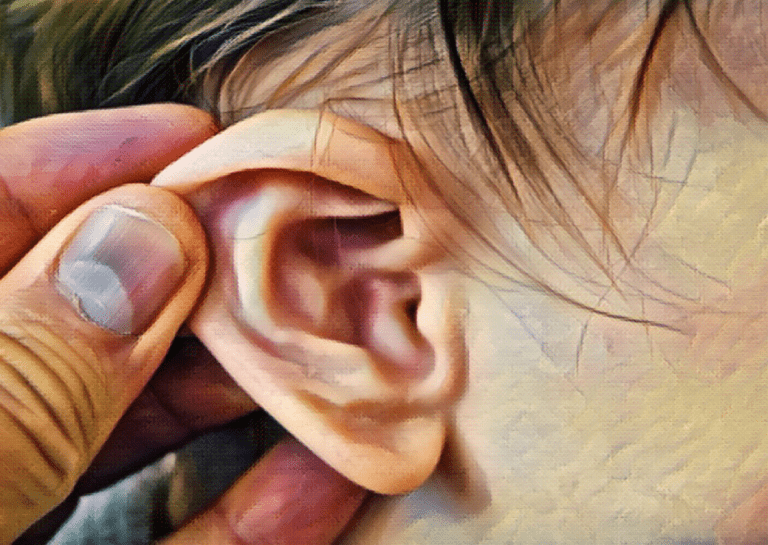Ear pain is a common affliction for babies and children and can be symptomatic of a number of different causes. Around 80-90% of infants will get an ear infection before they turn three. The most common causes of ear pain in infants are bacterial infections and viruses.
Causes of ear pain in infants
Ear infections often occur after a child has had a cold or bacterial infection of sort kind. A bacterial infection in the throat, for example, can travel to the inner ear, causing the infection to spread and lead to ear pain.
Another common cause of ear pain is Eustachian tube dysfunction. This occurs when the Eustachian tube — the passageway connecting the throat and middle ear — becomes clogged and infected. Infants are especially susceptible to this condition because their Eustachian tubes are much smaller, making it easier for them to become clogged.
Symptoms
When babies and young children are experiencing discomfort, it can be difficult for parents to distinguish between general fussiness and genuine pain. When it comes to ear pain, the symptoms can be similar to other conditions. However, there are some tell-tale symptoms to look out for that indicate an ear infection. These include:
- Child rubbing at their ear
- Discharge of fluid from ear
- Fever above 100˚F
- Child’s hearing appears reduced
- Crying more than usual
- Fussiness
- Restlessness
- Imbalance
- Poor appetite
- Poor sleep
Risk factors
Most infants will get an ear infection at some point, but certain factors will put them at a higher risk. For example:
- Infants or children between 6 months and 2 years of age are more susceptible to ear infections.
- Infants who have recently had a cold or bacterial infection are at higher risk of an ear infection.
- Children with chronic illnesses that cause weakened immunity are more likely to have recurring ear infections.
- Having allergies can increase the risk of ear infections due to inflammation and swelling that can block the Eustachian tube. Eustachian tube dysfunction is a common cause of ear infections, particularly in young infants.
- Children attending nurseries or daycare are more susceptible to ear infections because these environments allow for the spread of viruses that can cause infection.
- Infants who live with smokers more frequently develop ear infections because cigarette smoke irritates the airways, making them more vulnerable to bacterial infections. This is also the case for children who live in areas with high air pollution.
Complications
If left untreated for too long, ear infections can have significant complications ranging from mild to life-threatening.
Complications include:
- Hearing loss
- Learning disabilities (from impaired hearing)
- Eardrum perforation
- Mastoiditis (inflammation of Mastoid bone, located behind the ear)
When to see a doctor
Ear infections are one of the most common reasons for parents to bring their child to the doctor or pediatrician, but it is not always necessary to seek medical attention. Ear infections are not serious and usually clear up within three days. However, if your child’s ear infection does not go away on its own or their condition worsens, you should consult a doctor.
See a doctor if:
- Ear infection does not clear up after 2-3 days
- Your child’s fever lasts more than 2 days
- Your child is inconsolable due to pain
- Symptoms last more than 2 days
- There is a discharge of fluid or pus from the ear
- Your child is not drinking enough fluids or their appetite remains poor for more than 2 days
- Your child experiences recurring ear infections, or 3 infections within a 6-month period
How to treat ear pain at home
Although ear infections can clear up on their own without medical treatment, there are steps you can take to help the healing process and relieve any pain or discomfort your child is experiencing.
You can give your child acetaminophen for pain relief, but make sure to always consult a doctor or pharmacist about proper dosage. Antibiotics and antihistamines are generally not used for treating ear infections, but your doctor may recommend them in certain circumstances where allergies are contributing to the infection or the body’s immune system cannot clear the infection by itself.
You can try using a warm/cold compress to ease the pain. Children may prefer a warm compress as opposed to a cold one, but ensure it’s not too hot. You can alleviate the pain by holding a warm washcloth over the affected ear until the cloth becomes cool.
When treating an ear infection, the most important thing you can do is keep a close eye on your child’s symptoms and on the affected ear. Check regularly to see if there is any discharge from the ear, and also monitor your child’s temperature to determine whether they have a fever (temperature of 100.4˚F or higher).
References
“Conditions InDepth: Middle Ear Infection.” Winchester Hospital, www.winchesterhospital.org/health-library/article?id=19350.
Middle ear infections. Healthy Children—American Academy of Pediatrics website. Available at: https://www.healthychildren.org/English/health-issues/conditions/ear-nose-throat/Pages/Middle-Ear-Infections.aspx. Updated February 22, 2013.
“Treating Ear Infections in Children.” Harvard Health, Harvard Medical School, 23 Jan. 2017, www.health.harvard.edu/childrens-health/new-guidelines-for-treating-ear-infections.
